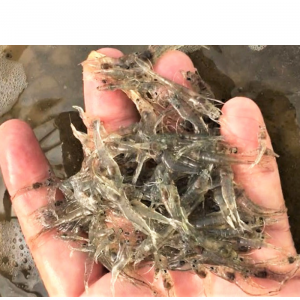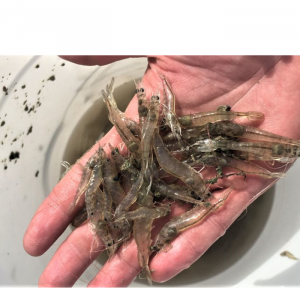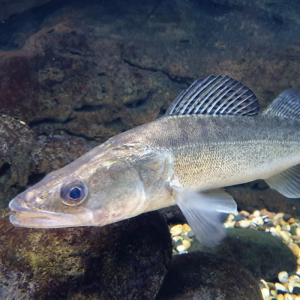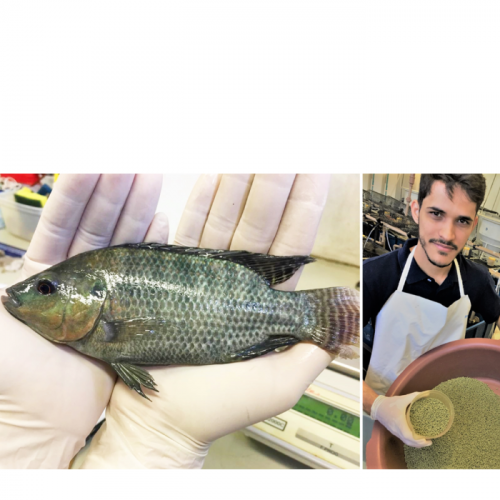
Effect of Exogenous Enzymes in Plant-Based Diets on Growth of Nile Tilapia Fingerlings
| Wed, 28 Apr 2021 - 09:02
Various vegetable ingredients are being used or have been proposed to replace ingredients like fishmeal to enhance the cost-effectiveness of aquafeeds. However, the cell walls of cereals and legumes currently used in tilapia feeds are widely known to impair the nutritive value of the feed, resulting in a negative impact on the growth performance and health of the fish.
Specifically, vegetable ingredients possess antinutritional factors that interfere with the absorption or hinder the bioavailability of nutrients, such as phytate and non-starch polysaccharides (NSP), which reduce their nutritive value. As alternatives to vegetable ingredients, exogenous [of external origin] enzymes – including phytase, xylanase, and β-glucanase – have been proposed to enhance the nutritive value of plant-based aquafeeds.
Phytate is the main form of unavailable phosphorus in legumes and cereals. The enzyme phytase increases the availability of phosphorus and other nutrients such as protein, starch, and cationic minerals. In contrast, NSPs, which are mainly composed of cellulose [an important structural component of the primary cell wall of green plants], arabinoxylans [dietary fiber found in cereal grains], and β-glucans [sugars found in the cell walls of fungi, bacteria, yeasts, algae, lichens and plants], increase intestinal viscosity and decrease the activity of digestive enzymes and digestibility.
Also read: Enhanced Biodiversity of Gut Flora, Feed Efficiency in Nile Tilapia Under Reduced-frequency Feeding
Therefore, the presence of non-starch polysaccharides and phytate exerts negative impacts on nutrient utilization and, consequently, the growth performance of fish. In addition, the high levels of unabsorbed nutrients, mainly phosphorus, induce eutrophication, which is the proliferation of cyanobacterial algae responsible for giving fish an off-flavor.
To overcome this problem, the addition of phytase and exogenous carbohydrases [enzymes that turn carbohydrates into simple sugars] has been proposed to increase the nutritional value of plant-based diets and reduce the output of nitrogen and phosphorus from aquaculture operations. Thus, this study evaluated the growth performance of Nile tilapia (Oreochromis niloticus) fingerlings fed extruded diets based on wheat bran and soybean meal, supplemented with a liquid blend of exogenous phytase and xylanase-β-glucanase.
Study setup
All experimental procedures for fish were performed following the guidelines of the State University of Ponta Grossa Animal Care and Use Committee (Protocol No. 132808/2019). Fish were anesthetized (100 mg/L) and euthanized (600 mg/L) with tricaine methanesulfonate (MS-222).
A control diet based on soybean meal was supplemented with 341 g/kg crude protein, 14.4 MJ/kg of digestible energy, 9 g/kg calcium, and 7 g/kg total phosphorus (dry matter basis). From the control diet (CON), three different experimental diets were created by adding phytase (PHY; 1,000 phytase units, FTU, per kg and xylanase-β-glucanase, XB; 1,120 xylanase units, TXU, per kg xylanase and 500 thermostable glucanase units, TGU, per kg of β-glucanase). Phytase units, FTU; xylanase units, TXU; and thermostable glucanase units, TGU are used to measure and describe the activity of these enzymes under very specific conditions.
The third diet was created by combining PHY and XB. Liquid phytase (Natuphos®E), and a blend of xylanase and β-glucanase (Natugrain®) exogenous enzymes (BASF, Ludwigshafen am Rhein, Germany) were used. The enzymes were dissolved in soybean oil and sprayed onto the tops of the extruded diets.
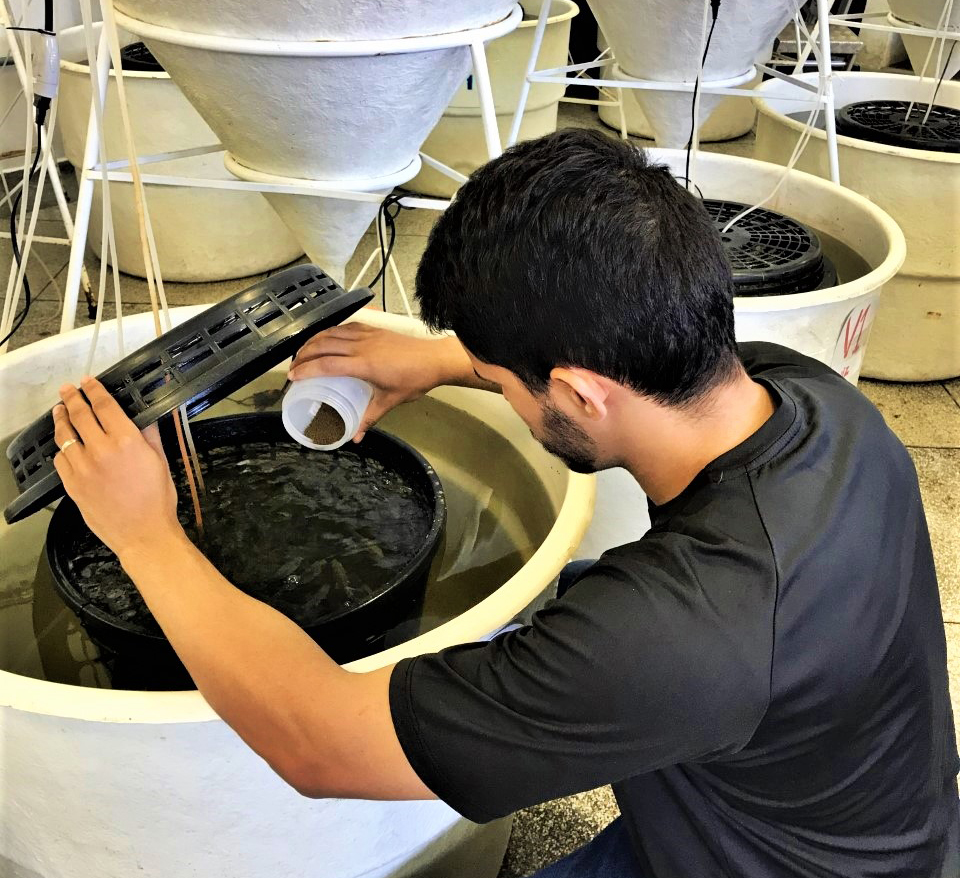
This study was carried out in a completely randomized design with four treatments and four replicates of 17 fish. Fish (n = 272; initial body weight 22.52 ± 0.20 grams) were distributed into 16-200-liter fiberglass tanks. The water temperature and dissolved oxygen were maintained at 27.2 ± 1.3 degrees-C and 5.85 ± 0.51 mg/L. Furthermore, the fish were hand-fed six times daily for 42 days. At the end of the feeding experiment, fish were weighed and assessments of whole-body composition (four fish per tank) and vertebral mineral content (two fish per tank) were made.
Exogenous enzymes
This study evaluated the effect of exogenous enzymes in plant-based diets on the growth of Nile tilapia fingerlings.
Additionally, feces were collected daily from each experimental tank to determine the apparent digestibility of protein (N × 6.25) and phosphorus. The resulting data were then entered into ANOVA and, in case of statistical difference, the means were compared by Tukey’s test (p < 0.05).
Results and discussion
The growth performance of the Nile tilapia fingerlings is shown in Table 1. The final body weight (g), body weight gain (percent), and feed conversion ratio were optimized in fish fed PHY, XB, and PHY+XB diets when compared to the control group (CON); while there was no difference among fish groups fed PHY, XB, and PHY+XB diets (p < 0.05).
Macêdo, exogenous enzymes, Table 1
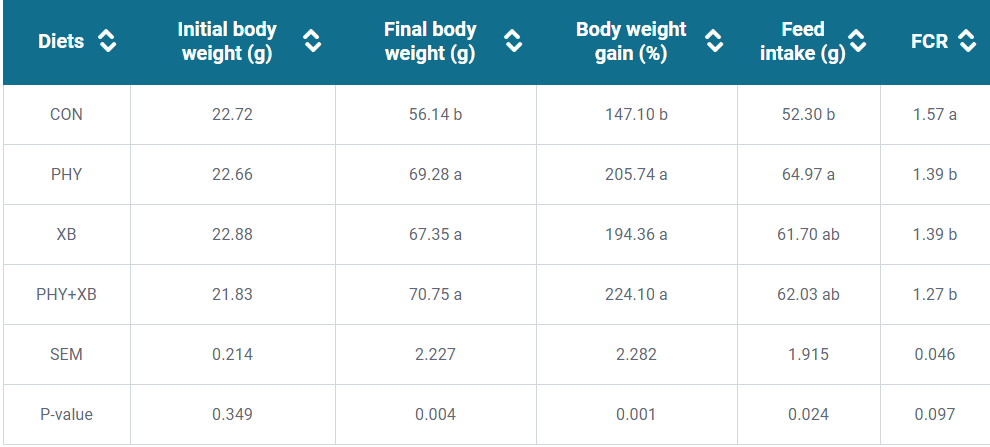
Table 1: Performance of Nile tilapia fingerlings fed diets based on soybean meal with supplementation of enzymes phytase and a xylanase/β-glucanase complex.
CON, control diet with no enzyme application; PHY, phytase-supplemented diet; XB, xylanase and β-glucanase supplemented diet; PHY+XB, phytase, xylanase, and β-glucanase supplemented diet; SEM, pooled standard error of the mean.
The means are of four replicate groups and values with the same column with different letters are significantly different (p < 0.05).
Also read: Combining Yucca Extract and Yeast in Tilapia Farming
The whole-body proximate composition and the vertebral ash content are shown in Table 2. Whole-body moisture and crude protein content were not affected by dietary treatments (p > 0.05). Conversely, fish fed a diet supplemented with a combination of phytase, xylanase and β-glucanase (PHY+XB) showed higher whole-body lipids, ash, and vertebral ash contents, than those fed the CON diet (p < 0.05). However, there was no difference in whole-body and vertebral ash between fish fed PHY and PHY+XB diets.

Table 2: Whole-body composition of Nile tilapia fingerlings fed diets based on soybean meal with supplementation of enzymes phytase and a xylanase/β-glucanase complex.
CON, control diet with no enzyme application; PHY, phytase-supplemented diet; XB, xylanase and β-glucanase supplemented diet; PHY+XB, phytase, xylanase, and β-glucanase supplemented diet; SEM, pooled standard error of the mean.
The means are of four replicate groups and values with the same column with different letters are significantly different (p < 0.05).
The combination of phytase, xylanase, and β-glucanase revealed a synergic effect, reducing phosphorus and nitrogen excretion in the fish. Compared to the control (CON), fish fed the PHY+XB diet showed reduced phosphorus and nitrogen excretion by 50.9 percent and 30.3 percent, respectively.
Overall, phytase and xylanase-β-glucanase blends, individually or in combination, improved the growth performance of Nile tilapia fingerlings. Moreover, the combination of phytase, xylanase and β-glucanase exerted synergistic effects on reduced phosphorus and nitrogen excretion and can thus contribute to sustainable aquaculture, in addition to their positive growth performance effects.
Also read: Influence Of Diet Type on Gut Microbiome, Nutrient Assimilation in GIFT Tilapia
Perspectives
The results of this study support the hypothesis that the addition of phytase, xylanase and β-glucanase would improve the growth performance of Nile tilapia that are fed all-vegetable diets. These exogenous enzymes play an important role in reducing potentially harmful phosphorus and nitrogen in the aquatic environment.
It is important to note that exogenous liquid enzymes are affected by high-temperature conditions during the grinding, extrusion, and drying processes involved in producing fish feed. For this reason, liquid enzymes may be top-coated after the drying process, providing a high residual level on the extruded pellets.
Source: Global Aquaculture Alliance













